Building Climate Resilience in the Blue Nile/Abay Highlands: A Framework for Action
Abstract
:1. Introduction
2. A Framework for Building Resilience to Climate Change

3. Vulnerability & Adaptive Capacity: The Choke Mountain Experience
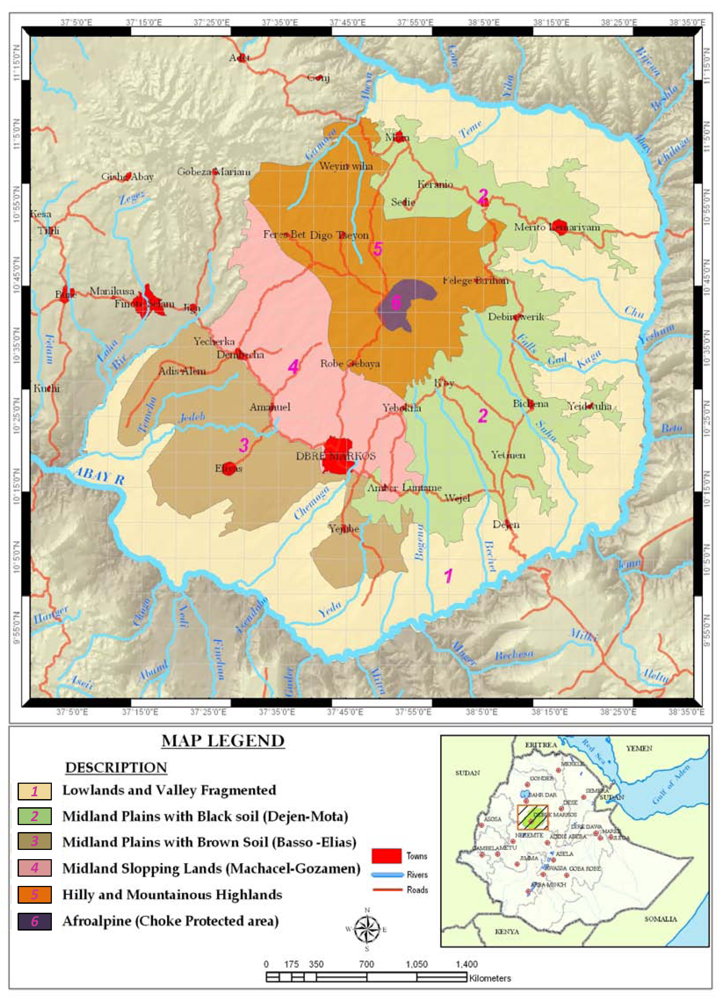
3.1. Farmers’ Perceptions
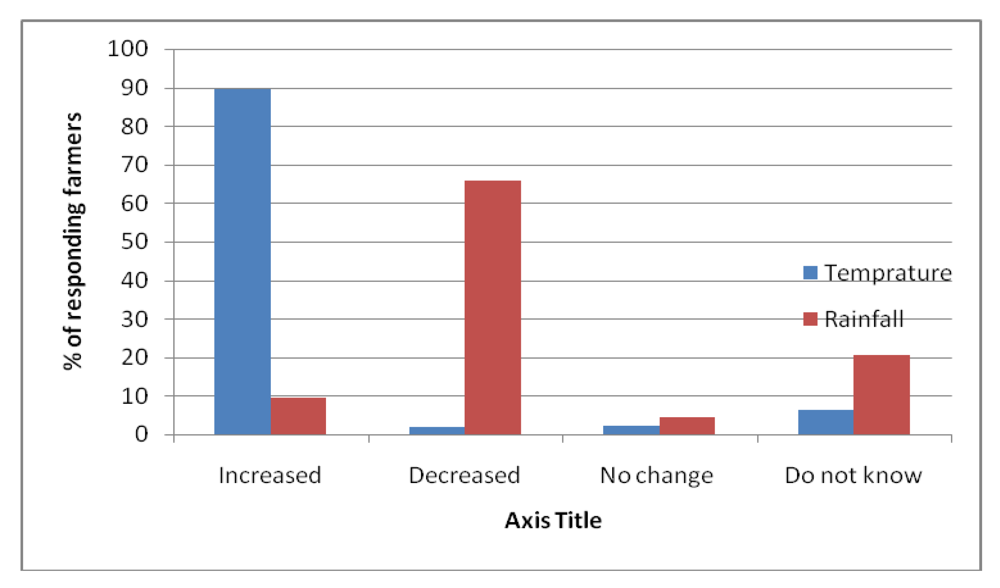
| AESs | Yes (%) | No (%) | ANOVA test | |
|---|---|---|---|---|
| F-value | Significance | |||
| Choke Mountain watersheds | 74.4 | 25.6 | 4.45 | 0.075 * |
| AES 5 (Very cold sub-moist mid highlands ) | 69 | 31 | ||
| AES 4 (Cool sub-moist mid highlands) | 85.7 | 14.3 | ||
| AES 3 (Temperate moist mid highlands ) | 58.3 | 41.7 | ||
| AES 2 (Cool -Moist Mid highlands ) | 85 | 15 | ||
| AES 1 (Warm sub-moist lowlands ) | 78.3 | 21.7 | ||
3.2. Vulnerabilities and Adaptive Capacity by AES
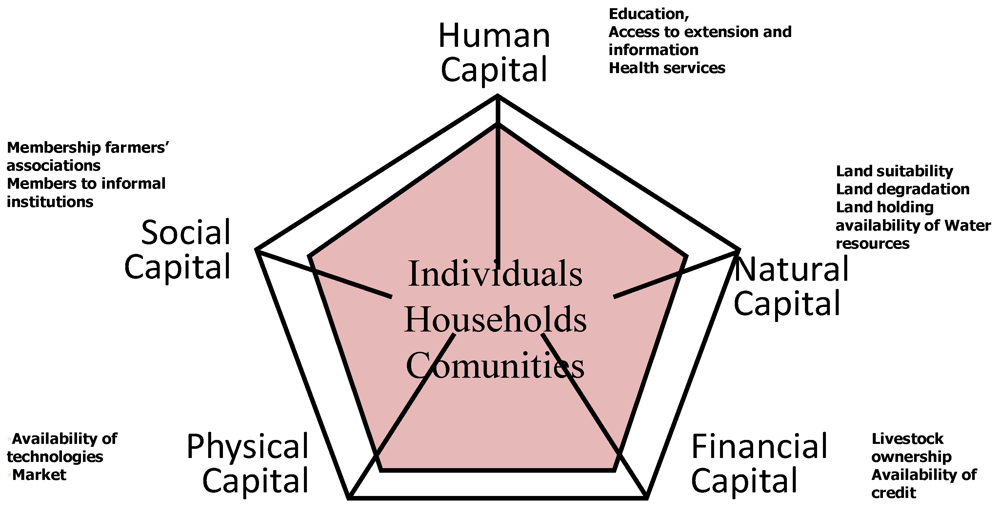
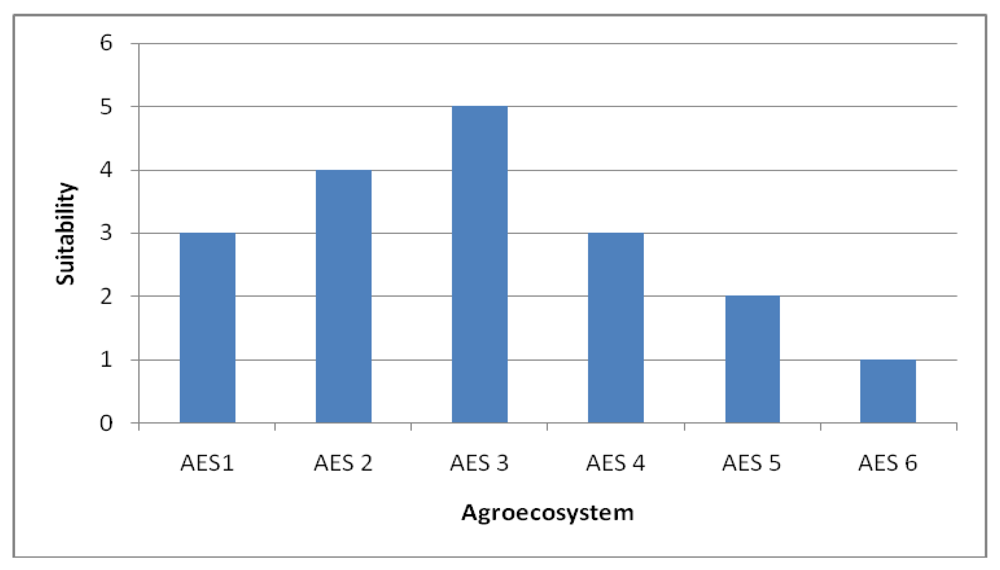

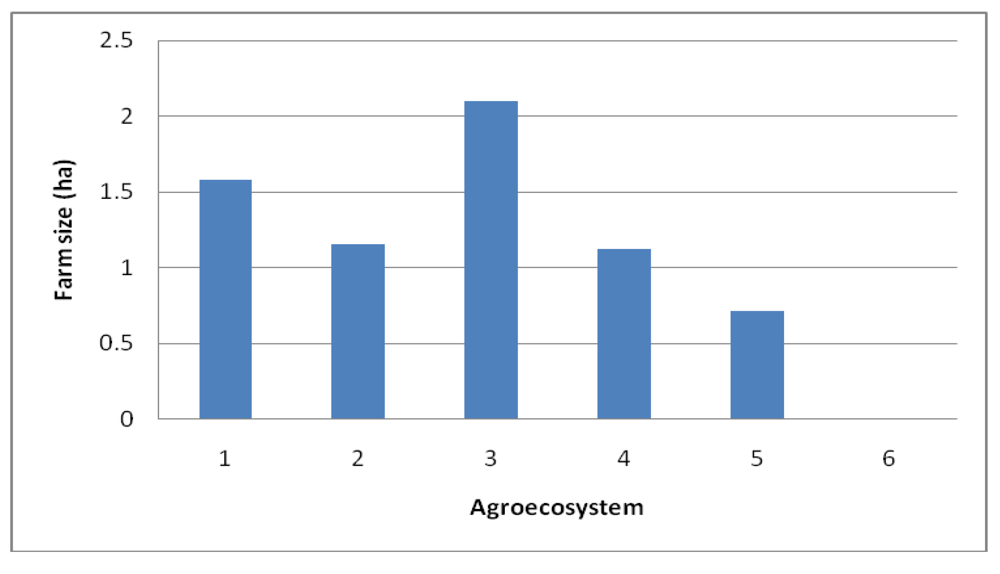
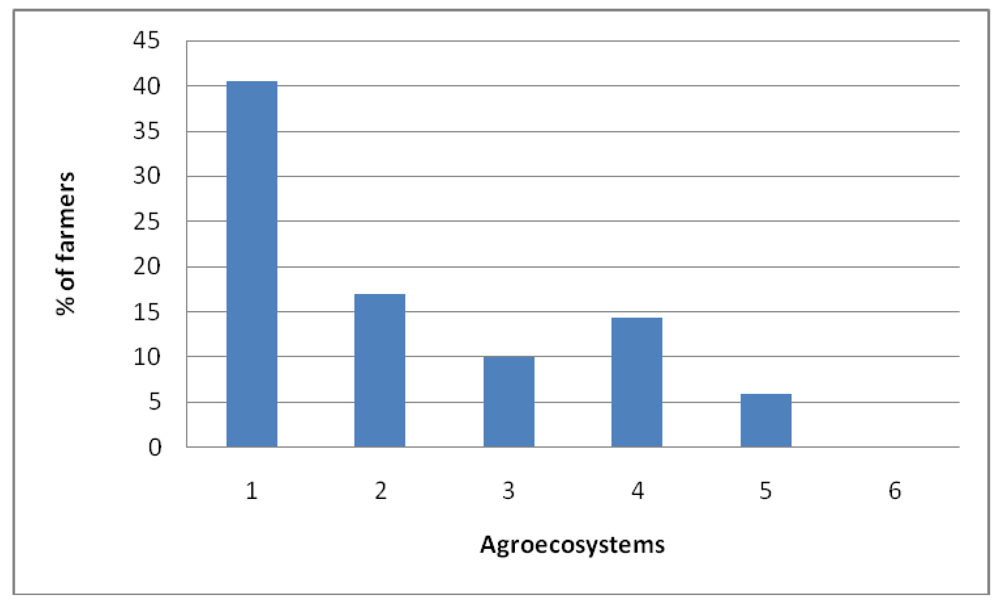

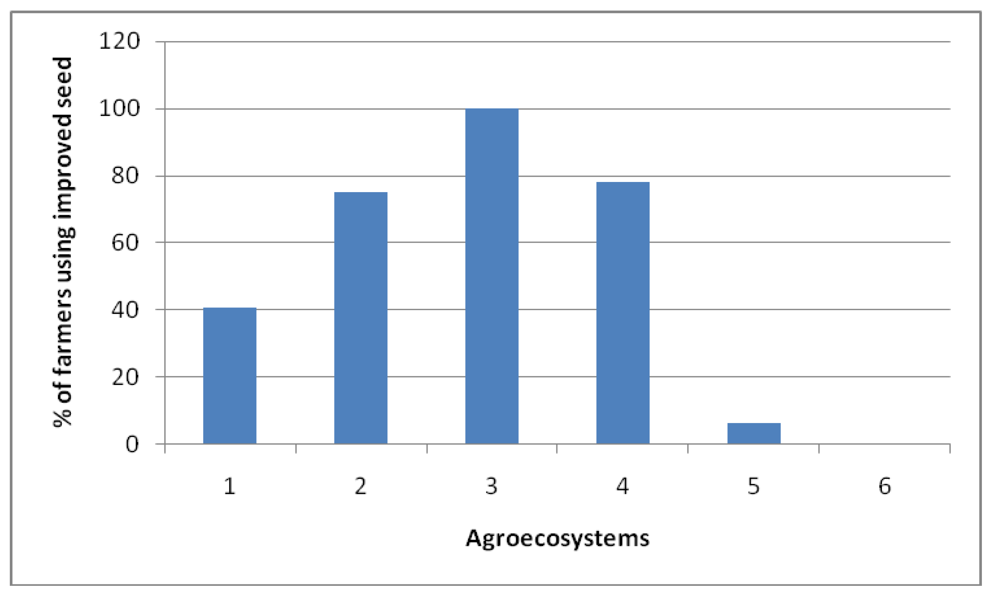
| AEZs | Soil conservation (%) | ANOVA test | |
|---|---|---|---|
| F-value | Significance | ||
| Choke Mountain watersheds | 66.7 | 1.89 | 0.09* |
| Very cold sub-moist mid highlands (AES 5) | 67.6 | ||
| Cold sub-moist mid highlands (AES 4) | 80.5 | ||
| Cool -Moist Mid highlands (AES 3) | 17.5 | ||
| Temperate moist mid highlands (AES 2) | 14.9 | ||
| Warm sub-moist lowlands (AES 1) | 87.1 | ||

3.3. Farmers’ Participation in Climate Change Adaptation Efforts
4. Opportunities and Challenges
4.1. Opportunities
- Investment potential: Even though communities in the Blue Nile/Abay highlands are relatively poor in their adaptive capacity, there are non-negligible livelihood assets and other resources available at the household and community levels that can be invested in improved adaptive capacity. The research confirms that it is possible to apply available adaptive capacities to sustainable adaptation actions, provided that investments are well planned and implemented with the full awareness and participation of community members.
- Past experience with climate extremes: Ethiopia is historically prone to extreme weather events. Rainfall is highly erratic, and most rain falls intensively, often as convective storms, with very high rainfall intensity and extreme spatial and temporal variability. Therefore there is a good opportunity to use past climate variability to inform future resilience strategies.
- Application of Earth System Science information: Earth System Science (ESS) is fundamental to advance our understanding of both natural and human systems. Institutions within Ethiopia and internationally are engaged in ESS studies relevant to the Blue Nile/Abay Highlands, and these efforts can be applied to informed climate adaptation in the region.
- Integration of ESS to the adaptation dialogue: Information from ESS and climate resilience analysis can be more effectively integrated to support policies and strategic decision support systems at the national and local level. Research at Choke Mountain has demonstrated that farmer perception and reactive adaptive actions are largely consistent with objective ESS analysis of recent climate variability in the region. This consistency suggests that there is great potential to inform proactive adaptation actions through consultative analysis of ESS projections relative to existing adaptive capacity at household and community level.
4.2. Challenges
- Low investment rate and population pressure: Ethiopia is one of the least developed countries in the world, even though the economy is reported to have grown by an average rate of 11 percent over the last five years. With a current population growth rate of about 2.8 percent per year, Ethiopia’s population is expected to reach 129 million by 2030 [26]. Because of poverty and high population pressure, which together result in extremely small landholdings, investment in improved land management is very low, leading to high susceptibility to adverse effects of climate variability and change. The natural resources base (land, water and biodiversity) is under intense pressure from population growth and inappropriate traditional farming and management practices.
- Inherent limits on agricultural productivity: Agriculture in the Blue Nile Highlands is mainly a subsistence, low input and output system. There are also widespread problems related to extensive cultivation, overgrazing and deforestation, and consequent soil erosion and soil fertility decline. Water scarcity, livestock feed shortages, and fuel wood needs are additional and significant pressures. The quality of land management has become an increasing matter of concern due to the additional stress of climate change. Land degradation problems are likely to be exacerbated by a rise in the frequency of extreme weather events.
- Uncertainty in the climate forecast: A major challenge for translating climate change assessments into adaptation policies and measures is persistent and deep uncertainty about future changes in climate conditions. For example, there is little consensus between different climate models regarding changes in precipitation amount, timing, and intensity. Uncertainty regarding future socio-economic states may be just as profound, yet climate vulnerability assessments commonly estimate the impacts of future climate changes based upon current social and economic conditions. This can lead to distorted perceptions of risk and appropriate adaptation responses.
5. Realizing Climate Resilience: The Role of Climate Innovation Platforms
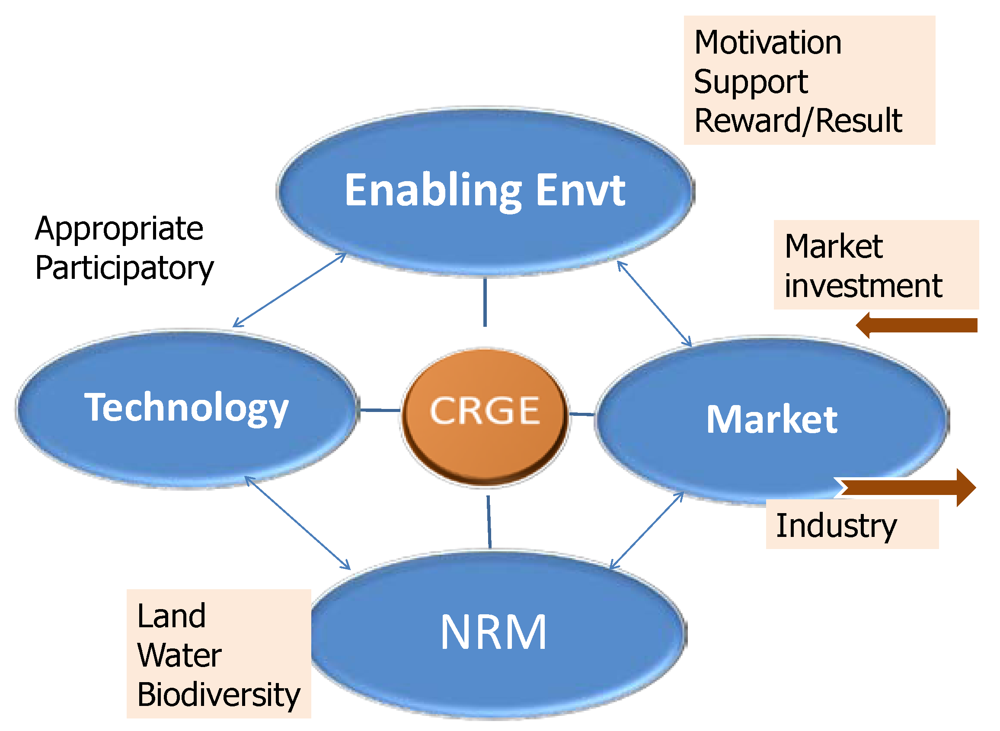
6. Conclusions and Recommendations
- The natural resources that are the foundation for the economy of the country are under intense pressure from population growth and inappropriate traditional farming and management practices. The quality of land management has become an increasing matter of concern due to the additional stresses of climate change and population growth. Although there are many approaches used, there remains considerable scope to further develop a clear conceptual framework and set of guidelines necessary to understand and measure vulnerability and to develop feasible adaptation strategies.
- The Choke Mountain watersheds are characterized by considerable biophysical and socio-economic diversity. Biophysical diversity in micro-climate, soil properties, vegetation types and water resources results in high spatial variability in climate impacts and associated response measures. Socio-economic diversity adds an additional set of considerations relevant to vulnerability and adaptation options. The ecosystem and livelihood framework applied at Choke Mountain is a useful tool for planning, monitoring and evaluation of climate impacts and adaptation strategies. It provides a method for advancing resilience against a baseline and for monitoring incremental change towards defined resilience outcomes, as established and evaluated by a diverse set of stakeholders. In this regard, the Choke Mountain study can be a model for development-relevant research in the context of climate change.
- In the Blue Nile Highlands, understanding of climate change, both its manifestation and its impacts, is limited to a few experts and decision-makers. Therefore, there is a need for a carefully conceived, evidence-based communication process that will enhance awareness of climate change and available response measures, for both policy makers and those involved in community-level development.
- Informed adaptation strategies must take into account available scientific data on climate change impacts and also the vulnerability and perceptions of stakeholders; at present, information on both physical and social aspects of climate adaptation is limited, as are strategies for adapting in the context of uncertainty within the climate resilience framework. To address this limitation, integrated research on both physical science and adaptive capacity is required: the design and implementation of adaptation measures should include not only technical aspects, but also the transformation of the socio-cultural patterns that link them to the environment.
- Due to a lack of information on the impacts of climate variability and climate change on ecosystems and community livelihoods, and due to our limited knowledge of socioecological dynamics, there are high levels of uncertainty regarding future projections and system responses. Such constraints could limit adaptation responses.
- Research results from Choke Mountain and elsewhere indicate that participatory technology development and implementation centers, established with broad participation from local stakeholders and national and international experts, offer an opportunity for effective and efficient technology development, uptake and dissemination. This model is being applied in the form of Innovation Platforms (IP) for the Ethiopian highlands.
- The major challenge is to translate the climate resilience framework into an effective, accountable, and democratic planning and negotiation process. In many parts of the country, decisions on land conservation and investments in productivity and sustainability of ecosystems are made by local administrators without the involvement of local communities. Since the participation of farmers is vital for the sustainability of land management, farmer priorities must be taken into account. Research on climate resilience should include farmer participation to identify methods for improving land productivity and return on their labour. This conclusion is consistent with the findings of a recent IUCN review of econsystem-based adaptation studies across several countries [27].
- Due to the aforementioned uncertainty, the design of adaptation measures must include a monitoring strategy that provides information about the effectiveness of all adaptation measures.
- The effective promotion of access to information on vulnerabilities, impacts and adaptation to climate change represents an indispensable element in building Ethiopia’s national response to climate change. Effective information dissemination and networking (in the right format, quality and language) enhances stakeholders’ knowledge base for proactive engagement on climate change and its effects, and creates a sound foundation for policy formulation and action on climate change adaptation.
Acknowledgments
Conflict of Interest
References and Notes
- Parry, M.L.; Canziani, O.F.; Palutikov, J.P.; van der Linden, P.J.; Hanson, C.E. Technical summary. In Climate Change 2007: Impacts, Adaptation and Vulnerability. Contribution of Working Group II to the Fourth Assessment Report of the Intergovernmental Panel on Climate Change; Cambridge University Press: Cambridge, UK, and New York, NY, USA, 2007. [Google Scholar]
- Simane, B. Building resilience to climate change and green economy in mountain ecosystems of ethiopia. Integrating research, capacity building and sustainable development activities. In Proceedings of the Stakeholders Workshop, Debre Markos, Ethiopia, 10–13 June 2011.
- Deressa, T. Economic Impact of Climate Change on Crop Production in Ethiopia; CEEPA, University of Pretoria: Pretoria, South Africa, 2007. [Google Scholar]
- Managing Water Resources to Maximize Sustainable Growth: A Country Water Resources Assistance Strategy; The World Bank: Washington, DC, USA, 2005.
- Dejene, A. Environment, Famine, and Politics in Ethiopia: A View from the Village; Lynne Rienner: London, UK, 2003. [Google Scholar]
- Tedla, S. Community-based natural resources management in Ethiopia. In Community Based Natural Resource Management in the IGAD Region; Aimbo, J., Barrow, E., Karaba, M., Eds.; Intergovernmental Authority on Development (IGAD): Djibouti, Djibouti, 2004; pp. 77–106. [Google Scholar]
- Conway, D.; Lisa, E.; Schipper, F. Adaptation to climate change in Africa: Challenges and opportunities identified from Ethiopia. Glob. Environ. Change 2010, 21, 227–237. [Google Scholar]
- Simane, B. Climate change: Impacts and responses for carbon neutral and cliamte resilient development in Ethiopia. J. Nat. Resour. 2011, in press. [Google Scholar]
- Folke, C.; Carpenter, S.; Walker, B.; Scheffer, M.; Elmqvist, T.; Gunderson, L.; Holling, C.S. Regime shifts, resilience, and biodiversity in ecosystem management. Annu. Rev. Ecol. Evol. Syst. 2004, 35, 557–581. [Google Scholar] [CrossRef]
- McCarthy, J.J.; Canziani, O.F.; Leary, N.A.; Dokken, D.J.; White, K.S. Climate Change 2001: Impacts, Adaptation, and Vulnerability. Contribution of Working Group II to the Third Assessment Report of the Intergovernmental Panel on Climate Change: Annex B–Glossary of Terms; Cambridge University Press: Cambridge, UK, and New York, NY, USA, 2001. [Google Scholar]
- Walker, B.; Holling, C.S.; Carpenter, S.R.; Kinzig, A. Resilience, adaptability and transformability in social-ecological systems. Ecol. Soc. 2004, 9, 5. [Google Scholar]
- CARE. Climate Vulnerability and Capacity Analysis Handbook; CARE International: Atlanta, GA, USA, 2009. Available online: http://www.careclimatechange.org/cvca/CARE_CVCAHandbook.pdf (accessed on 9 February 2012).
- Chinwe, I.S. Resilient Adaptation to Climate Change in African Agriculture; Deutches Institute fur Entwicklungspolitick: Bonn, Germany, 2010. [Google Scholar]
- Fussel, H.M.; Klein, R.J.T. Climate change vulnerability assessments: An evolution of conceptual thinking. Clim. Change 2006, 75, 301–329. [Google Scholar]
- Holling, C.S. Resilience and sability of ecological systems. Annu. Rev. Ecol. Evol. Syst. 1973, 4, 1–23. [Google Scholar]
- Zaitchik, B.F.; Simane, B.; Foltz, J.; Ozdogan, M.; Abate, H.; Mesfin, D.; Habib, S. Climate resilience in the Blue Nile/Abay Highlands: Part II—The role of earth system sciences. Int. J. Environ. Res. Public Health 2012, 9, 435–461. [Google Scholar]
- Simane, B. The Choke Mountain Research and Development Initiative: Sustaining the Ecosystem of the Blue Nile Basin—A Strategic Framework; Addis Ababa University: Addis Ababa, Ethiopia, 2007. [Google Scholar]
- Asfaw, S. The Economic Impacts of Climate Change on Crop Agriculture and the Role of Agricultural Technologies towards Better Adaptation: A Case in Choke Mountain Watersheds of Ethiopia; Addis Ababa University: Addis Ababa, Ethiopia, 2011. [Google Scholar]
- Maddison, D. The Perception of and Adaptation to Climate Change in Africa; CEEPA Discussion Paper No. 10; CEEPA, University of Pretoria: Pretoria, Aouth Africa, 2006. [Google Scholar]
- Proceedings of the First National Climate Change Conference, Addis Ababa, Ethiopia, 15 January 2009; National Climate Change Forum (NCCF): Addis Ababa, Ethiopia, 2009.
- Deressa, T.; Claudia, R.; Mahmud, Y.; Rashid, M.; Tekie, A. Analyzing the Determinants of Farmers’ Choice of Adaptation Methods and Perceptions of Climate Change in the Nile Basin of Ethiopia; IFPRI Discussion Paper No 00789; CEEPA, University of Pretoria: Pretoria, South Africa, 2008. [Google Scholar]
- Dessalegne, D. Local Level Assessment of Farmers’ Vulnerability to Climate Change and Variability: A Case Study of Choke Mountain East Gojjam; Addis Ababa University: Addis Ababa, Ethiopia, 2011. [Google Scholar]
- Simane, B. Local-Level Environmental Action Plan for Development (LEAD); Institute of Development Research, Addis Ababa University: Addis Ababa, Ethiopia, 2008. [Google Scholar]
- Ayehu, A. Nature and Determinants of Participation in Community based Participatory Watershed Management in Choke Mountain: The Case of Chemoga Watershed, East Gojjam, Ethiopia; Addis Ababa University: Addis Ababa, Ethiopia, 2010. [Google Scholar]
- CIDSE, The Importance of Adaptation Technologies for the post-2012 Climate Agreement; CIDSE and Caritas Internationalis: Brussels, Belgium, 2009.
- Ethiopia’s Growth and Transformation Plan (GTP), 2011/12–2014/15; Ministry of Finance and Economic Development: Addis Ababa, Ethiopia, 2010.
- Shepherd, G. The Ecosystem Approach: Learning From Experience; IUCN: Gland, Switzerland, 2008. [Google Scholar]
© 2012 by the authors; licensee MDPI, Basel, Switzerland. This article is an open-access article distributed under the terms and conditions of the Creative Commons Attribution license (http://creativecommons.org/licenses/by/3.0/).
Share and Cite
Simane, B.; Zaitchik, B.F.; Mesfin, D. Building Climate Resilience in the Blue Nile/Abay Highlands: A Framework for Action. Int. J. Environ. Res. Public Health 2012, 9, 610-631. https://0-doi-org.brum.beds.ac.uk/10.3390/ijerph9020610
Simane B, Zaitchik BF, Mesfin D. Building Climate Resilience in the Blue Nile/Abay Highlands: A Framework for Action. International Journal of Environmental Research and Public Health. 2012; 9(2):610-631. https://0-doi-org.brum.beds.ac.uk/10.3390/ijerph9020610
Chicago/Turabian StyleSimane, Belay, Benjamin F. Zaitchik, and Desalegn Mesfin. 2012. "Building Climate Resilience in the Blue Nile/Abay Highlands: A Framework for Action" International Journal of Environmental Research and Public Health 9, no. 2: 610-631. https://0-doi-org.brum.beds.ac.uk/10.3390/ijerph9020610




